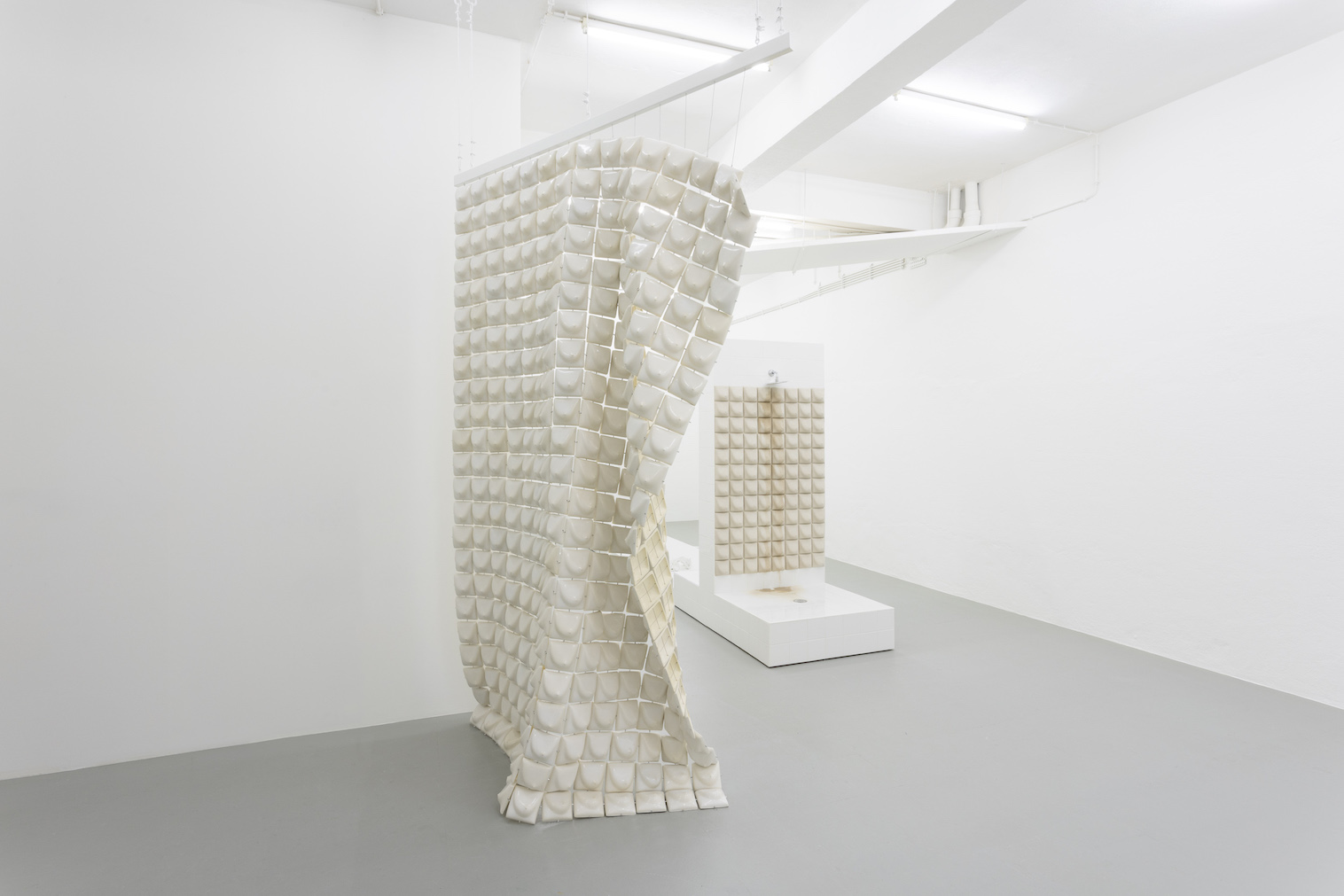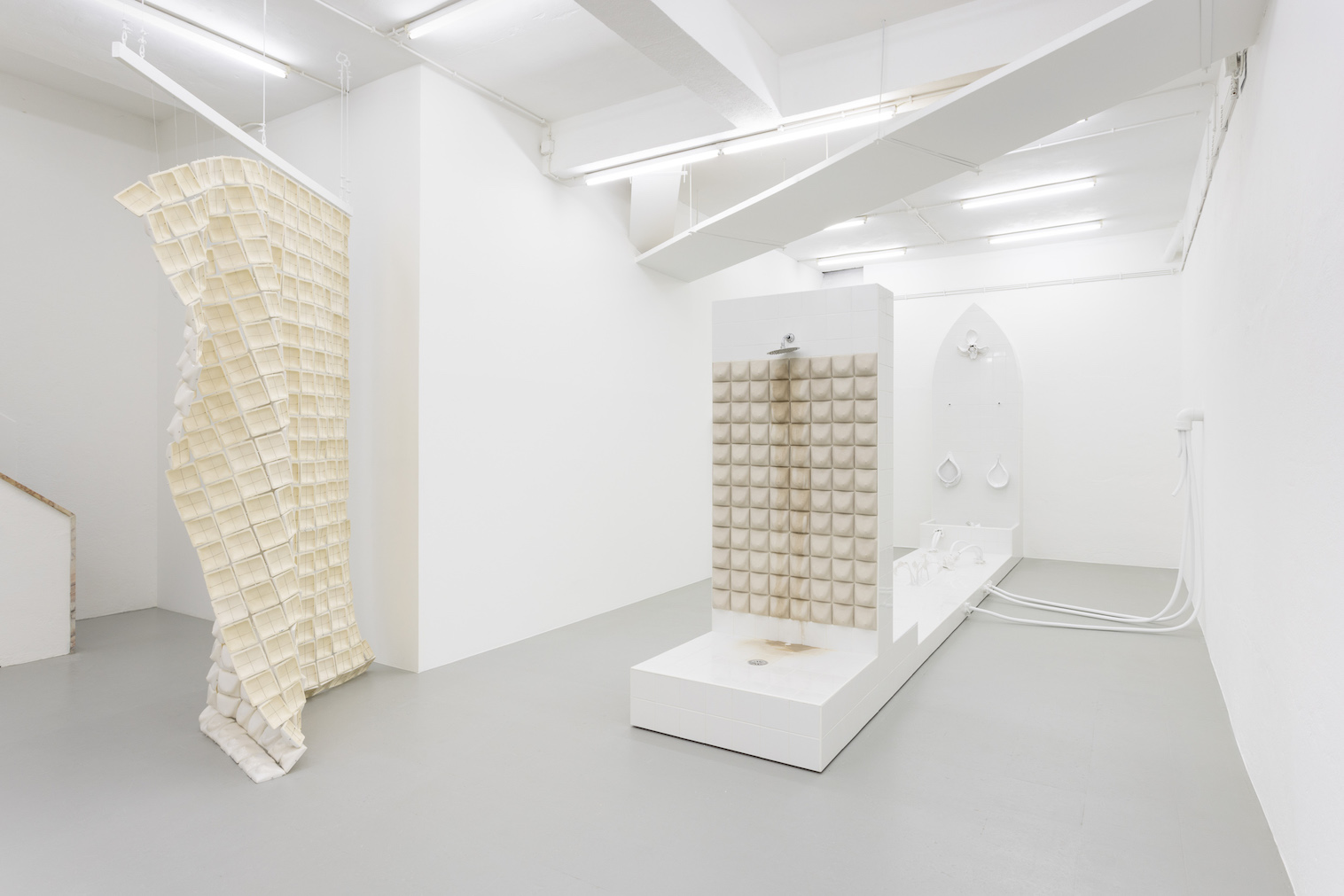Inês Zenha: Ressurreição

Inês Zenha’s Ressureição connects complexities of gender and transformation to critical questions of persistence and survival.[1] The artist’s first solo exhibition in Portugal presents an acute philosophical statement through a multifaceted all-white installation of a bath. A shower curtain obstructs the initial view of the main installation, which consists of an abandoned shower, a set of basins with water pouring from one to the other, and a tiled platform connected to the side walls via lifelike tubes, in addition to an altar with a sculpted orchid flower and several basins mirroring the first basin set. The installation is completed by sculptures of plants growing from the drains and tiles of the platform in its midst.
A constant sound of running water pervades the exhibition, evoking the uncanny serenity of an unfamiliar shrine. It is this sound of water that the viewer first encounters, as it is heard from behind Trespassing the armed gaze, which obstructs our initial view. This piece is an enlarged shower curtain armour made out of wired ceramic tiles. Upon closer inspection each tile reveals itself to be a factory-made ceramic replica of a breast, apparently a copy of the artist’s. The curtain’s rigid form is disturbed by a slight opening in the top right corner—as if someone has torn it down when invading a space not intended for the public.
The most striking piece is seen directly upon entering past the curtain: A body remains in confession, which represents a turned-off shower. Here, the same breast tiles make up six neat columns, three on each side. The two middle columns have been torn down, forming a heap of mud and broken tiles—broken breasts. Although the rupture of order may metaphorically represent a liberation, the repetition of this disruption strengthens the feeling of the viewer-as-trespasser entering a hurriedly abandoned space.
On the backside of the wall of A body remains in confession is Raise my voice, a vertical fountain structure of basins followed by a tiled platform that connects to the altarpiece at the back wall of the room. It is this sound of water pouring from one genitalia-shaped basin opening to another in the vertical structure that shifts the viewer’s feeling from curiosity to uncanniness, as if we’re overhearing someone relieving themselves through a bathroom door cracked open. This first half of the installation is completed by big, blooming weed plants that have made their way through the tiles and drains of the vertical platform. Their perseverance harkens to the initial question of feminism, the question of survival,[2] and connects directly to the non-Christian definition of the word ‘resurrection’: a new beginning for something which has disappeared, grown old or become unwanted. It also relates to rebirth and the connected terminology in trans discourse referring to transitioning as the gender assigned at birth; the name and so on is left behind for the new life as one’s new self.
This creation of a permanent metaphysical space for resurrection and self-reinvention speaks to Zenha’s ability to combine acquired research and lived experience into a well-formulated visual language.
Seen through the lens of Judith Butler’s defining discourse on gender studies, Ressurreição insists on the desire of continuous resurrection that at once invites and rejects any witness to the transformation thereto. The broken state of the tiles of A body remains in confession and the emptiness of the space amplified by its whiteness indicates that we enter the bath after a transformative event. The resurrection has already taken place, and we as an audience become one with a society that continuously penetrates people’s inner space of self-reinvention. The armour of the initial shower curtain is, it would seem, not strong enough to prevent this penetration, any influence of which on the resurrection itself rendered impossible by the space, already having been abandoned.
It is in this paradox of being seen and unseen, of defining oneself and being driven to define oneself by the society, that Ressurreição finds its metaphysical queer space.
According to Butler, this very paradox of agency between the I and society ‘is the condition of its impossibility. // As a result, the “I” that I am finds itself at once constituted by norms and dependent on them but also endeavours to live in ways that maintain a critical and transformative relation to them.’[3] The paradox appears in our invasion of a space of rebirth and resurrection, unwillingly but purposefully performed for and by the audience. By formulating this encounter, Ressurreição differs from other small-scale exhibitions in its philosophical depth and the wide range of emotions that it evokes.
The title’s duality continues that of the paradox. Its Christian definition as the resurrection of Jesus Christ and of all people when the world ends is a direct reference to the show’s Portuguese context—as is the prevalence of tiles, once again contrastingly white instead of the traditional coloured pattern of azulejos. The altar part of the installation that speaks to this second meaning of the resurrection, Purify me in your becoming-water, is purposefully placed furthest away. In a resistance to the Portuguese Catholicism that for many remains a limiting, unaccepting space, it subverts the Christian altar: in the place of a cross with a pre-resurrection Christ is a blooming orchid, while the basins below subvert the act of baptism with the sculpted growth creating surreal sculptures of survival despite all odds.
Zenha tells me that the orchid is, in fact, Orphys, which biologists have long labelled as 'strange,' 'wrong' and 'morally corrupt.' To this day the Orphys is commonly referred to as 'prostitute orchid' as the flowers mimic the scent, appearance and texture of female bees.[4] Instead of giving its pollinators nectar, it uses the resemblance to attract male bees to attempt fornication, depositing pollen onto their heads while they are engaged in the sex act. The same bees come back over and over again, for pleasure rather than for need, a biological scenario that the boxed patriarchal order continues to find provoking.
Instead of being limited to specifically queer matter as the press surrounding the show may suggest, Ressurreição expands queer theory into acute human and posthuman questions related to the process of becoming.[5] It is through the shared understanding of the continuous inner transformation that informs performativity, as much as the performativity itself, that we are invited to engage with emotionally and critically.
The days after visiting the exhibition, I was left with a gnawing frustration of the show providing a static, calming place instead of political action and anger. It took some time before I realised that my demand of the space to be an active political agent had made me into a perpetrator of this sacred yet repeatedly violated and forcefully politicised process-space of rebirth, self-definition and resurrection. Ressurreição builds this locus by embracing both sides of the paradox: static-moving, whole-broken, seen-unseen, rigid-disrupted, defined-undefined. It shows us that only if we embrace this paradox of resurrection as the location of both transformation and remaining oneself can we begin to untangle our own liberation.
Maria Kruglyak is a researcher, critic and writer specialising in contemporary art and culture. She is the editor-in-chief and founder of culturala, a network-based art and cultural theory journal which experiments with a direct, welcoming language for contemporary art. She holds an MA in History of Art from SOAS, University of London, where she focused on East and Southeast Asian contemporary art. She completed a curatorial and editorial internship at MAAT in 2022 and is currently working freelance as an art writer.
Proofreading: Diogo Montenegro.


Inês Zenha: Ressurreição. Exhibition views at Kunsthalle Lissabon. Photos: Bruno Lopes. Courtesy of the artist and Kunsthalle Lissabon.
Notes:
[1] A play on a sentence in Judith Butler’s introduction to Undoing Gender (Routledge, 2004), p. 4: ‘The essays in this text are efforts to relate the problematics of gender and sexuality to the tasks of persistence and survival.’
[2] Butler, ‘The Question of Social Transformation,’ Undoing Gender, p. 205.
[3] Butler, ‘Introduction: Acting in Concert,’ Undoing Gender, p. 3.
[4] Conversation with Inês Zenha, 25 February 2023.
[5] It is the questions of ‘who and what we are actually in the process of becoming’ that, according to Rosi Braidotti, relate directly to the ‘posthuman condition [that] urges us to think critically and creatively about’ these very questions. See Braidotti, The Posthuman (Polity, 2013), p. 12.










